
I used to think freezing French toast was ridiculous.
Why freeze something that takes ten minutes to cook?
But mornings hit differently now. Between deadlines, errands, and that “I’ll just grab coffee” energy, breakfast is often the first thing to go.
So when my chef friend casually mentioned that he batch-cooks and freezes French toast for quick breakfasts, I was curious.
Spoiler: it actually works, and tastes good.
Why You’d Even Want to Freeze French Toast

For me, it started with time.
Some mornings, even ten minutes feels like a luxury. Freezing French toast isn’t about laziness, it’s about survival. When you’ve got a busy week ahead, being able to grab a slice, toss it in the toaster, and eat real food instead of another protein bar just makes sense.
But there’s more to it than just speed. Freezing French toast also cuts down on waste. You can turn a few days-old slices of bread, leftover milk, and the last couple of eggs into something genuinely good.
Turns out, a lot of people online figured this out long before I did. On Reddit, r/Frugal and r/Cooking are full of people swapping tips about it.
“French toast uses a lot of the ingredients that go bad too quick if you’re single. It’s the equivalent of using old bananas for banana bread.”
— u/nateusmc, r/Frugal
Another user explained how they prep big batches for their family:

“Yup. I do this to save time making breakfast for our toddler. I use a gallon-sized freezer bag and separate them with aluminum foil. We can then pull out however many pieces we need.”
— u/Elmosfriend
What Bread Freezes Best (Tested)

If you want your French toast to hold up beautifully after freezing, the bread matters more than you think.
I wanted a professional’s take, so I spoke with Chef Trevanne Donegal of SEAR274, a professional pastry chef with over 15 years of experience in high-end bakeries. Her advice was clear:
“You need a thicker-cut bread, something that can soak up the egg mixture without falling apart. Brioche or challah work best because they’ve got a real texture and weight to them. American sandwich bread is too light and airy, the slices are too thin to hold up, especially if you plan to freeze them later.”
After testing a few types myself, I completely agree. The rich, dense loaves like brioche or challah stay tender on the inside and crisp on the outside after reheating, while thinner sandwich bread just turns soft and soggy.
| Bread Type | Freezer Performance | Notes |
| Brioche | ⭐⭐⭐⭐ | Soft, rich, perfect texture after reheating. |
| Challah | ⭐⭐⭐⭐ | Slightly drier, still great flavor. |
| Texas Toast | ⭐⭐⭐ | Sturdy, reliable, great for kids. |
| White Sandwich Bread | ⭐⭐ | Tends to get soggy; best used fresh. |
How to Freeze French Toast: A Step-by-Step Guide

Once you’ve made your French toast, the rest is easy. Here’s exactly how to freeze it so it tastes just as good later.
1. Cook and Cool Completely
Make your French toast like you normally would. Before you freeze it, let the slices cool completely on a wire rack or parchment-lined tray.
This step matters: any trapped steam turns into ice crystals, which is how you end up with soggy toast later.
2. Flash Freeze the Slices
Lay your cooled slices in a single layer on a baking sheet. Pop the tray into the freezer for 30–60 minutes, just until the French toast feels firm to the touch.
This “flash freeze” keeps the slices from sticking together in storage.
My Little Tip: The same flash-freeze method works perfectly for freezing pancakes and freezing waffles too, so you can batch-cook your entire breakfast lineup in one go.
3. Stack with Wax Paper (Optional but Smart)
If you’re freezing a bunch at once, separate each slice with a small piece of wax paper or parchment paper.
That way, you can pull out exactly how many you need later, no hacking apart frozen toast bricks.
4. Wrap and Protect
For the best freezer life, wrap each slice (or stack) tightly in plastic wrap. If you want to go the extra mile, add a layer of aluminum foil, it’s your best defense against freezer burn.
Alternatively, skip the double-wrap if you’re using a heavy-duty, freezer-grade zip-top bag.
5. Seal, Label, and Store
Transfer the wrapped slices into an airtight freezer bag or container. Press out as much air as possible before sealing, air is the enemy of texture.
Remember to label with the date, so you know how long it’s been sitting there.
If you’re more of a visual learner, here is a TikToks that shows you how to do it.
Related: Can You Freeze Waffles?
How to Reheat Frozen French Toast (Quick Overview)
Once your French toast is frozen solid, the magic happens when you reheat it.
There are a few ways to do it, toaster, oven, air fryer, each giving slightly different results.
For a full breakdown (including exact times, temperatures, and which method keeps the best texture), check out my detailed guide:
👉 How to Reheat French Toast the Right Way (No Soggy Edges)
How Long It Actually Lasts
Most guides claim frozen French toast lasts up to 3 months, but in my experience, 4–6 weeks is the sweet spot. Beyond that, it still tastes okay but loses that fresh-griddled aroma.
Food safety-wise, the USDA says cooked bread and egg dishes are fine for a few months if frozen airtight — but flavor always fades first.
To store longer, use freezer-grade bags and press out every bit of air before sealing.
Would I Do It Again?
Absolutely. Freezing French toast has become my go-to move for those super busy mornings.
It’s one of those small kitchen habits that makes life feel a little more put together, like you’re doing something nice for your future self.
Pull a slice from the freezer, toss it in the air fryer, and five minutes later, it’s warm, crisp, and comforting.
If you’ve ever thought “why bother freezing French toast?”, trust me, try it once. You’ll get it.